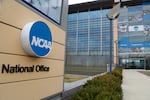
FILE - NCAA headquarters in Indianapolis is shown March 12, 2020. Starting July 1, 2025, Oregon universities can directly pay athletes for NIL under an expected NCAA legal settlement, prompting schools to raise more funds in a competitive sports landscape.
Michael Conroy / AP
Sports programs at Oregon’s major universities raise millions of dollars a year — and they’re going to have to raise a lot more to keep up with the increasingly competitive landscape of paying student-athletes.
Starting July 1, schools like the University of Oregon and Oregon State University will be able to directly pay players for use of their name, image or likeness. That’s under a legal settlement a federal judge is expected to approve this week.
“It’ll be the largest redistribution of wealth in the United States aside from Social Security and Medicare,” Jason Belzer, founder of Student Athlete NIL, said. “You’re going to have more individuals aged 18-22 that are going to have money on campuses than ever before in history.”
College athletes have been able to profit from use of their name, image and likeness — referred to as NIL — since 2021. But so far, students have had to work with third-party groups to get paid. Now, colleges will be allowed to share around $20 million in revenue per year directly with student-athletes.
Related: University of Oregon athletics expected to thrive with changes coming to NIL
Belzer, who also teaches sports business law at Rutgers University, said the changes will double the amount of money spent on student-athlete NIL deals to $2 billion per year.
It’s all thanks to what’s called the House settlement, which U.S. District Court Judge Claudia Wilken is expected to approve in some form any day.
The settlement started as three separate lawsuits from student-athletes against the NCAA regarding the chaotic rollout of NIL rules. One of the cases is House vs. NCAA filed by former Arizona State University swimmer Grant House. Former UO basketball player Sedona Prince is another lead plaintiff in that case.

College basketball player Sedona Prince leaves federal court during a hearing for the $2.8 billion House vs. NCAA lawsuit on Monday, April 7, 2025, in Oakland, Calif.
Noah Berger / AP
After the House lawsuit and two others were rolled into one class action case, the sides agreed to settle, with a final hearing last week. Lawyers are negotiating final details related to potential roster limits and how to value athletes in the future.
The two biggest components of the settlement expected to stay intact are:
- Schools being able to directly pay athletes.
- Back pay totaling around $2.75 billion for student-athletes who didn’t get to profit fairly from NIL dating back to 2016, to be paid out over the next decade.
“The proposed settlement would facilitate meaningful opportunities for student-athletes to further benefit from their participation in intercollegiate athletics,” the NCAA said in a March statement about the House settlement, “while establishing a robust system of oversight and controls to ensure fair competition and protect the integrity of collegiate athletics and the best interests of student-athletes, participating institutions and fans.”
Experts in the nascent NIL industry say federal lawmakers will likely need to step in to put even more protections in place for student-athletes.
Potential impact on smaller sports programs
Belzer is an advocate for student-athletes being fairly compensated, but says the changes coming from the House settlement will deal a blow to smaller schools and sports programs that don’t bring in money.
“Non-revenue generating sports — particularly women’s sports — are most likely to suffer,” Belzer said. “It’s more likely than not, at schools that are trying to figure out how to make their books balanced, that they will start cutting non-revenue sports positions.”
He doesn’t think that will happen at schools like UO because of strong outside support, mainly from Nike co-founder and Oregon alum Phil Knight. But it will put pressure on other programs.
“If the Oregons of the world are figuring it out, then the Oregon States, they better figure it out, too,” he said. “Because their bill is just going to get higher.”
Overall, Belzer said the House settlement is a major shift in the NIL world, but it’s just the beginning.
“It is going to create some guardrails around the process,” Belzer said. “But it is not a panacea, and there are still a lot of unanswered issues.”

